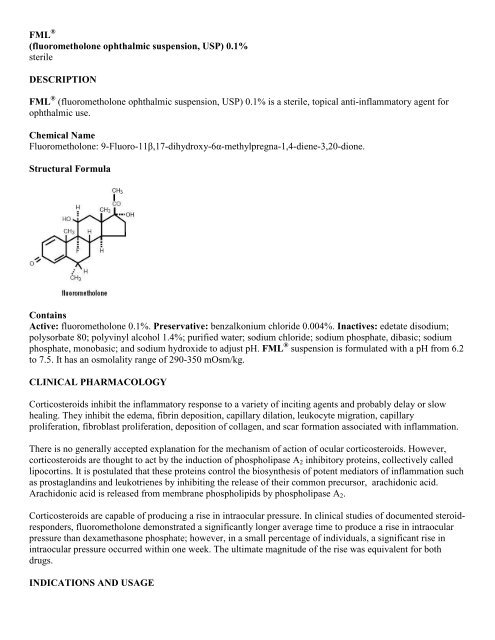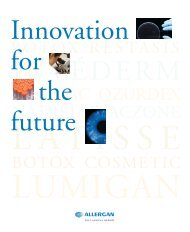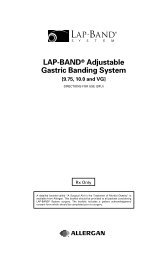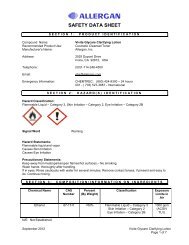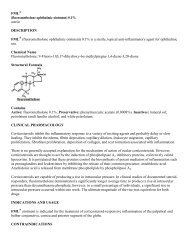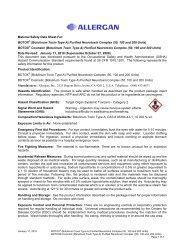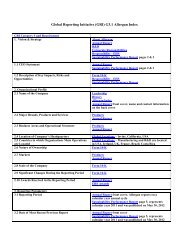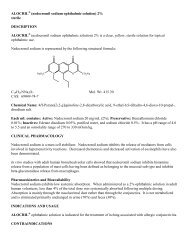FML® (fluorometholone ophthalmic suspension, USP) 0.1% - Allergan
FML® (fluorometholone ophthalmic suspension, USP) 0.1% - Allergan
FML® (fluorometholone ophthalmic suspension, USP) 0.1% - Allergan
You also want an ePaper? Increase the reach of your titles
YUMPU automatically turns print PDFs into web optimized ePapers that Google loves.
FML ®(<strong>fluorometholone</strong> <strong>ophthalmic</strong> <strong>suspension</strong>, <strong>USP</strong>) <strong>0.1%</strong>sterileDESCRIPTIONFML ® (<strong>fluorometholone</strong> <strong>ophthalmic</strong> <strong>suspension</strong>, <strong>USP</strong>) <strong>0.1%</strong> is a sterile, topical anti-inflammatory agent for<strong>ophthalmic</strong> use.Chemical NameFluorometholone: 9-Fluoro-11β,17-dihydroxy-6α-methylpregna-1,4-diene-3,20-dione.Structural FormulaContainsActive: <strong>fluorometholone</strong> <strong>0.1%</strong>. Preservative: benzalkonium chloride 0.004%. Inactives: edetate disodium;polysorbate 80; polyvinyl alcohol 1.4%; purified water; sodium chloride; sodium phosphate, dibasic; sodiumphosphate, monobasic; and sodium hydroxide to adjust pH. FML ® <strong>suspension</strong> is formulated with a pH from 6.2to 7.5. It has an osmolality range of 290-350 mOsm/kg.CLINICAL PHARMACOLOGYCorticosteroids inhibit the inflammatory response to a variety of inciting agents and probably delay or slowhealing. They inhibit the edema, fibrin deposition, capillary dilation, leukocyte migration, capillaryproliferation, fibroblast proliferation, deposition of collagen, and scar formation associated with inflammation.There is no generally accepted explanation for the mechanism of action of ocular corticosteroids. However,corticosteroids are thought to act by the induction of phospholipase A 2 inhibitory proteins, collectively calledlipocortins. It is postulated that these proteins control the biosynthesis of potent mediators of inflammation suchas prostaglandins and leukotrienes by inhibiting the release of their common precursor, arachidonic acid.Arachidonic acid is released from membrane phospholipids by phospholipase A 2 .Corticosteroids are capable of producing a rise in intraocular pressure. In clinical studies of documented steroidresponders,<strong>fluorometholone</strong> demonstrated a significantly longer average time to produce a rise in intraocularpressure than dexamethasone phosphate; however, in a small percentage of individuals, a significant rise inintraocular pressure occurred within one week. The ultimate magnitude of the rise was equivalent for bothdrugs.INDICATIONS AND USAGE
Information for PatientsIf inflammation or pain persists longer than 48 hours or becomes aggravated, the patient should be advised todiscontinue use of the medication and consult a physician.This product is sterile when packaged. To prevent contamination, care should be taken to avoid touching thebottle tip to eyelids or to any other surface. The use of this bottle by more than one person may spread infection.Keep bottle tightly closed when not in use. Keep out of the reach of children.The preservative in FML ® <strong>suspension</strong>, benzalkonium chloride, may be absorbed by soft contact lenses. Patientswearing soft contact lenses should be instructed to wait at least 15 minutes after instilling FML ® <strong>suspension</strong> toinsert soft contact lenses.Carcinogenesis, Mutagenesis, Impairment of FertilityNo studies have been conducted in animals or in humans to evaluate the possibility of these effects with<strong>fluorometholone</strong>.PregnancyTeratogenic effects. Pregnancy Category CFluorometholone has been shown to be embryocidal and teratogenic in rabbits when administered at lowmultiples of the human ocular dose. Fluorometholone was applied ocularly to rabbits daily on days 6-18 ofgestation, and dose-related fetal loss and fetal abnormalities including cleft palate, deformed rib cage,anomalous limbs and neural abnormalities such as encephalocele, craniorachischisis, and spina bifida wereobserved. There are no adequate and well-controlled studies of <strong>fluorometholone</strong> in pregnant women, and it isnot known whether <strong>fluorometholone</strong> can cause fetal harm when administered to a pregnant woman.Fluorometholone should be used during pregnancy only if the potential benefit justifies the potential risk to thefetus.Nursing MothersIt is not known whether topical <strong>ophthalmic</strong> administration of corticosteroids could result in sufficient systemicabsorption to produce detectable quantities in human milk. Systemically-administered corticosteroids appear inhuman milk and could suppress growth, interfere with endogenous corticosteroid production, or cause otheruntoward effects. Because of the potential for serious adverse reactions in nursing infants from<strong>fluorometholone</strong>, a decision should be made whether to discontinue nursing or to discontinue the drug, takinginto account the importance of the drug to the mother.Pediatric UseSafety and effectiveness in infants below the age of two years have not been established.Geriatric UseNo overall differences in safety or effectiveness have been observed between elderly and younger patients.ADVERSE REACTIONSAdverse reactions include, in decreasing order of frequency, elevation of intraocular pressure (IOP) withpossible development of glaucoma and infrequent optic nerve damage, posterior subcapsular cataract formation,and delayed wound healing.Although systemic effects are extremely uncommon, there have been rare occurrences of systemichypercorticoidism after use of topical dermatologic steroids applied to the skin.
Corticosteroid-containing preparations have also been reported to cause acute anterior uveitis and perforation ofthe globe. Keratitis, conjunctivitis, corneal ulcers, mydriasis, conjunctival hyperemia, loss of accommodationand ptosis have occasionally been reported following local use of corticosteroids.The development of secondary ocular infection (bacterial, fungal and viral) has occurred. Fungal and viralinfections of the cornea are particularly prone to develop coincidentally with long-term applications of steroids.The possibility of fungal invasion should be considered in any persistent corneal ulceration where steroidtreatment has been used (see WARNINGS).Transient burning and stinging upon instillation and other minor symptoms of ocular irritation have beenreported with the use of FML ® <strong>suspension</strong>. Other adverse events reported with the use of <strong>fluorometholone</strong>include: allergic reactions; foreign body sensation; erythema of eyelid; eyelid edema/eye swelling; eyedischarge; eye pain; eye pruritus; lacrimation increased; rash; taste perversion; visual disturbance (blurryvision); and visual field defect.DOSAGE AND ADMINISTRATIONShake well before using. Instill one drop into the conjunctival sac two to four times daily. During the initial 24to 48 hours, the dosing frequency may be increased to one application every four hours. Care should be takennot to discontinue therapy prematurely.If signs and symptoms fail to improve after two days, the patient should be re-evaluated (see PRECAUTIONS).The dosing of FML ® <strong>suspension</strong> may be reduced, but care should be taken not to discontinue therapyprematurely. In chronic conditions, withdrawal of treatment should be carried out by gradually decreasing thefrequency of applications.HOW SUPPLIEDFML ® (<strong>fluorometholone</strong> <strong>ophthalmic</strong> <strong>suspension</strong>, <strong>USP</strong>) <strong>0.1%</strong> is supplied sterile in opaque white LDPE plasticbottles with white high impact polystyrene (HIPS) caps as follows:5 mL in 10 mL bottle NDC 11980-211-0510 mL in 15 mL bottle NDC 11980-211-10Storage: Store at 2°-25°C (36°-77°F); protect from freezing. Store in an upright position.Revised: 02/2013© 2013 <strong>Allergan</strong>, Inc.Irvine, CA 92612, U.S.A.® marks owned by <strong>Allergan</strong>, Inc.Made in the U.S.A.71598US11


